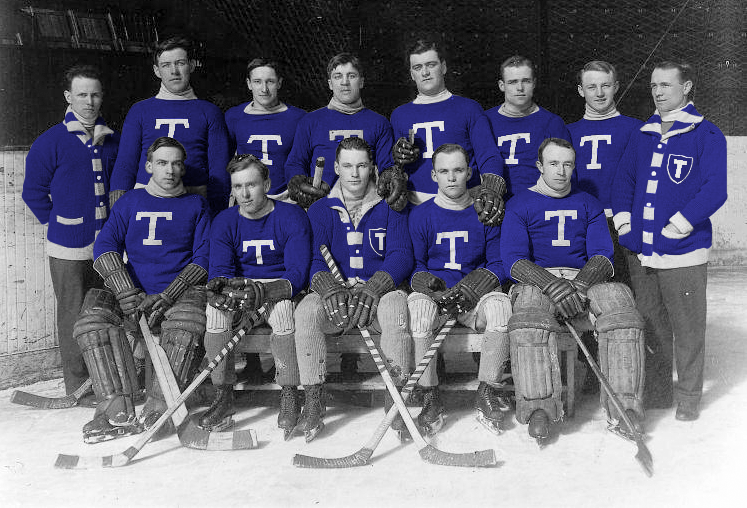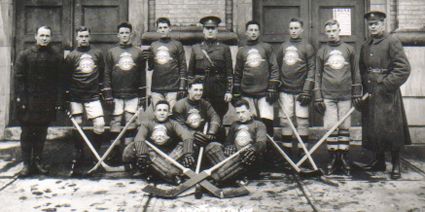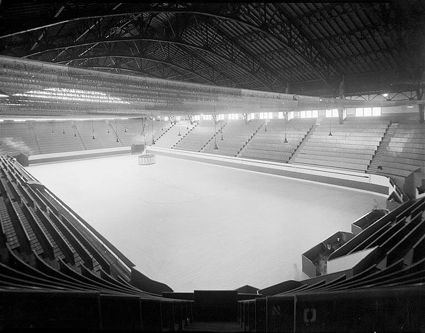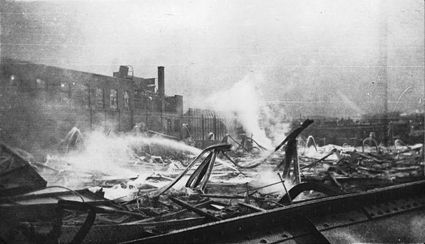With the Quebec Bulldogs suspending operations due to financial difficulties before the new NHL could even begin the 1917-18 season, the Arena Gardens were awarded a temporary NHL franchise, managed by Charlie Querrie, making the fledgling NHL a four team league once again. The league also assigned the Blueshirts players on a lease basis to the temporary Toronto franchise. To further complicate matters, many of the players had signed contracts with both Livingstone and the Arena.
The season, and the league, would kick off on this date in 1917 when Toronto lost to the host Montreal Wanderers in front of 700 fans by a score of 10-9. The Wanderers Dave Ritchie scored the first goal in NHL history, while Harry Hyland had four goals to record the league's first hat trick in short order. In the day's other game, the Ottawa Senators lost to the Montreal Canadiens 7-4 in Ottawa.
The Canadiens would win the first half of the season to earn a spot in the postseason championship playoff, while the Wanderers opening night win would be their only one in the NHL, as they would cease operations following the fire that burned down their home, the Montreal Arena, on January 2nd after just six games of their schedule and the Wanderers at a dismal 1-5 record.
Team owner Lichtenhein had already made a request from the other clubs to loan the Wanderers better players to field a more competitive team in hopes of attracting more fans, but when the plan was rejected by his fellow owners following the fire, and with his club dealing with the loss of their home arena, Lichtenhein disbanded the club on January 4, ending the Wanderers fourteen year history.
The aftermath of the Montreal Arena fire
The Toronto club had no official nickname, but the "Blueshirts" were successful on the ice, winning the second half of the season schedule and earned the right to play Montreal for the championship. Toronto was led by Reg Noble, who scored 30 goals and 10 assists in 20 games for 40 points, third overall in the league behind the prolific Joe Malone of the Canadiens who scored a spectacular 44 goals in just 20 games as part of his league leading point total. Corbett Denneny and Harry Cameron also were standouts for Toronto, with 29 and 27 points respectively, for fifth and sixth in league scoring. Toronto's Harry "Hap" Holmes came in second to Georges Vezina of Montreal in the goaltending department with a goals against average of 4.80 in 16 games.
Toronto defeated the Canadiens for the league championship in a two games, total goals series 10-7, capturing the O'Brien Cup. Toronto then faced off against the Vancouver Millionaires of the PCHA and won the Stanley Cup by 3 games to 2, causing Livingstone to again head to court to file suit for the revenue earned by "his" championship squad of players.
As a result of this lawsuit, the Arena Gardens formed a new company, the Toronto Arena Hockey Club Company, to own and run a hockey team separate from the Arena Gardens business in order to protect the Arena business from Livingstone's lawsuits. The NHL then awarded a "new" franchise to the Hockey Club Company. This club was officially named the Toronto Arenas and, not surprisingly, was stocked with the same players from the 1918 championship club. When his players were once again not returned to him for the 1918-19 season, Livingstone sued the Arena Gardens.
Once again, the players were uncertain who would prevail in the courts and covered their bases by signing contracts with both the Toronto Arena Hockey Club Company and Livingstone.
Livingstone did prevail in the courts sometimes, but not always. Two rulings in his favor of $20,000 and later $100,000 sent the Arena Gardens into bankruptcy. Despite the company's legal wranglings at the time, the arena would continue to operate for 77 years until closing in 1989.
When the Toronto Arenas did take to the ice in the 1918-19 season as Stanley Cup Champions, they did not play like it. Forced to sell most of their star players due to mounting legal bills, the Arenas record for the season was 5 wins and 13 losses, attendance was low and several players left the team. Finally, the team wrote to the league requesting that the season be ended when each of the three clubs had reached 18 games played and then officially withdrew from the league. This left only the Canadiens and Senators to play for the championship of the NHL and the right to meet the Pacific Coast Hockey Association champions for the Stanley Cup, which Montreal won 4 games to 1.
Meanwhile, Livingstone was busy was attempting to overthrow the NHA management, purchased the dormant Quebec Bulldogs franchise, and began an unsuccessful attempt to start a rival league, the Canadian Hockey Association and threatened to file an injunction to stop the NHL from operating. He also made unsuccessful attempts to start new leagues in 1920, 1924 and 1926, none of which ever played a single game.
Finally, the Toronto Arenas franchise was sold to the St. Patricks Hockey Club of Toronto, who ran the successful senior amateur St. Patricks team in the Ontario Hockey League, which included Arenas team manager Querrie in the four-man ownership group, in December of 1919.
The new owners renamed the club the Toronto St. Patricks and the $5,000 sale price was supposed to go to Livingstone to settle the purchase of his NHA club, for which he had once demanded $20,000 for after they had won the 1918 Stanley Cup. However, Livingstone never received the money, which many believe was kept by NHL president Frank Calder.
The Toronto St. Patricks were members of the NHL through the 1926-27 season, when Querrie, having been sued by none other than Livingstone, was forced to sell the St. Patricks. He reached an agreement to sell the club to Conn Smythe, who renamed the club the Toronto Maple Leafs and constructed Maple Leaf Gardens in 1931.
Today's featured jersey is a 1917-18 Toronto Blueshirts Hap Holmes jersey as worn during the inaugural season of the National Hockey League. Their jerseys would change for the second NHL season with the addition of white stripes around the arms and the word "Arenas" across the front, bisected by the large T crest from the previous season.
Holmes would win the Stanley Cup four different times, and with four different teams. He first joined Eddie Livingstone's Toronto Blueshirts of the NHA in 1912, winning the cup with them in 1914. He joined the Seattle Metropolitans of the PCHA in 1915 and won the cup with Seattle in 1917.
In his only season with the Toronto Blueshirts, he would win his third Stanley Cup before returning to Seattle the following season. After the Metropolitans folded four seasons later, Holmes would join the WCHL's Victoria Cougars in 1924 and go on to win his fourth Stanley Cup, the last cup won by a non-NHL team. After one more season in Victoria, the entire WCHL folded and the Victoria Cougars players were sold to the new Detroit NHL franchise, which took the name the Cougars as a tribute to the Victoria club before eventually becoming the Red Wings. Holmes would play his final two seasons in Detroit and conclude his career with 408 games played, 198 wins, 40 of which were shutouts, 192 losses and 14 ties.
Holmes was inducted into the Hockey Hall of Fame in 1972 and the American Hockey League award for the top goaltender each season is named the Hap Holmes Memorial Award.















